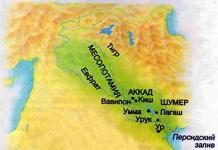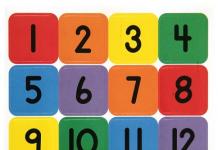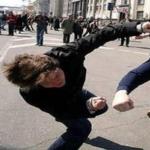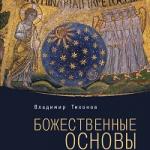Children first begin learning a foreign language in kindergarten. Learn simple words that are found in everyday life. Every first grader should know how to count within ten in English. This is a basic program that a child must master when entering school. Numbers in English can be learned not only easily, but also in a fun way. Today, many interesting ways and methods have been invented for this.
Learning numbers from 1 to 19
English numbers from 1 to 100 are easy to count and learn if you approach the learning process with ingenuity. To quickly master a new language, you need to understand the process of creating an invoice. At the initial stage, it is worth learning only 12 numbers, which will help you master the entire grammatical series. Every schoolchild and adult knows them. Therefore, any parent can teach their child with ease.
First you need to memorize the numbers from 1 to 12. A special table will help you do this.
| Number | Name in Russian | Name in English + how to spell the word | |
| 1 | One | one | One |
| 2 | Two | twu | That |
| 3 | Three | three | Fries |
| 4 | Four | Four | Fo |
| 5 | Five | five | Fife |
| 6 | Six | six | Syks |
| 7 | Seven | seven | Sevn |
| 8 | Eight | eight | Eyt |
| 9 | Nine | nine | Nine |
| 10 | Ten | ten | Ten |
| 11 | Eleven | eleven | Elevn |
| 12 | Twelve | twelve | tuelv |
The presented English number series is usually taught in poetic form, so it is easy to remember.
Counting from 13 to 19, knowing the previous numbers by heart will be easy. To do this, you need to learn how to compose a number series yourself using learned numbers.
To get 13, you need to add the suffix teen (teen) to the number 3, you get three (free) + teen (teen) = thirteen (fetin). The same rule applies to the numbers five and four:
- four (fo) + teen (teen) = fourteen (fotin) - 14;
- five (fife) + teen (tin) = fifteen (fiftin) - 15.
This series can be continued until 19: 16 - sixteen, 17 - seventeen, 18 - eighteen, 19 - nineteen. If a child understands the process of forming numbers from 1 to 20, English will become the child’s favorite language, which is not at all difficult to learn on your own or with the help of your parents.
Making tens
Tens in English are just as interesting to learn as other numbers in counting. Because they are formed according to the same pattern as the previous numbers. Round numbers are obtained by adding the suffix ty. For example, to understand how to pronounce and write 20, 30, 40, 50, you need:
This creates a table of round tens.
| Number | Name in Russian | Approximate pronunciation in Russian | Title in English |
| 20 | Twenty | Twenty | Twenty |
| 30 | Thirty | Soti | Thirty |
| 40 | Fourty | Foti | Forty |
| 50 | Fifty | Fifty | Fifty |
| 60 | Sixty | Sixty | Sixty |
| 70 | Seventy | Seventy | Seventy |
| 80 | Eighty | Ayti | Eighty |
| 90 | Ninety | Ninety | Ninety |
It is worth remembering how the numbers 50, 40, 30, 20 are written and pronounced. These are exception words. During their formation, the root is modified.
Getting the rest of the numbers from one to one hundred is also not difficult. Any schoolchild can do this if he understands the technology of their education. An example can be given using numbers 54 and 45:
- 54 consists of fifty and four, so in English it would sound like fifty (50) + four (4) = fifty-four (fifty-fo);
- 45 consists of forty (forty) and five (five), resulting in forty-five (forty five).
As shown above, the number is made up of tens and ones, which is closely related to the Russian language - 20 (twenty) + 5 (five) = 25 (twenty-five). In your native language, numbers are readable. This makes the learning process easier.
Any child will be able to understand the pattern of creating the numbers four, five, ten, twenty-four, etc. up to 100 if his parents help him and guide him. Already in elementary school, he will have extensive acquaintance with English and British pronunciation and their differences. In the first grades, children are already learning how to write and pronounce numbers up to 100. Therefore, it is extremely important to help your child master a foreign language perfectly before entering school.
Baby! Don't be afraid to learn something new! If you know numbers in Russian, then you will definitely know how they are written and pronounced in English. In that distant country of England, numbers are written and pronounced a little differently, they are not at all complicated. Now let's look a little at the history of numbers.
A short course on the history of numbers
There used to be primitive people, they explored this world, just like you do now. And they noticed that they had five fingers on each hand. Look at your hand now. Do you see? You have five fingers. And the second hand has five fingers. And if you add them up, it turns out that you have ten fingers on both hands. People realized that numbers could be written down somehow, for example on stones, because there were no pens and pencils then.
You may ask, why should I write it down? Well, you can, for example, write down a number on paper and remember that they bought you two ice creams yesterday and now you already need three ice creams. Now we will stop at the history course and move straight to the numbers.
Table of numbers from 1 to 20
| Number | Number name in English | Transcription of English numerals | Approximate pronunciation of an English number in Russian | The name of the English number in Russian |
| 0 | zero | [´ziərəu] | ´zierou | zero |
| 1 | one | one | one | |
| 2 | two | that:* | two | |
| 3 | three | [θri:] | sri:** | three |
| 4 | four | fo: | four | |
| 5 | five | five | five | |
| 6 | six | syx | six | |
| 7 | seven | sevn | seven | |
| 8 | eight | eith | eight | |
| 9 | nine | nain | nine | |
| 10 | ten | ten | ten | |
| 11 | eleven | i´levn | eleven | |
| 12 | twelve | tuelv | twelve | |
| 13 | thirteen | [θə:´ti:n] | sho´ti:n** | thirteen |
| 14 | fourteen | fo´ti:n | fourteen | |
| 15 | fifteen | fifty:n | fifteen | |
| 16 | sixteen | syx´ti:n | sixteen | |
| 17 | seventeen | sevn´ti:n | sevn´ti:n | seventeen |
| 18 | eighteen | hey:n | eighteen | |
| 19 | nineteen | nain´ti:n | nineteen | |
| 20 | twenty | [´twenti] | tu´enti | twenty |
Want to learn more numbers? For example.
The rules for reading numbers in English are in many ways similar to reading numbers in Russian. So, when pronouncing three-digit numbers, the hundreds place is called first, then the tens and ones.
Seven hundred and ninety three
seven hundred ninety three
From the example it is clear that reading numbers in english after the hundreds place is followed by the union and. Its presence is not mandatory, so and can be omitted. Although, in practice, this union is convenient. Especially for those who first think in their native language, and then produce a phrase in English. Pronouncing the word and leaves time to remember how to pronounce this or that part of the number.
When pronouncing numbers that have four or more digits, reading the number begins with the most significant digits and ends with the hundreds, tens, and ones digits. Numbers are pronounced in threes. Each three digits are read according to the rules for reading three-digit numbers, only at the end they add the words: “billions”, “millions”, “thousands” and so on. Let's give an example:
one trillion, three hundred and twenty-nine billion, seven hundred and eighty million, one hundred and ninety-one thousand, four hundred and twenty-five
one trillion three hundred twenty-nine billion seven hundred eighty million one hundred ninety-one thousand four hundred twenty-five
It is necessary to pay attention to the fact that such category names as: “hundreds”, “thousands”, “millions”, “billions” and so on, in English are always pronounced in the singular; accordingly, they do not have the ending -s.
Six hundred and fifty four
six hundred fifty four
When reading fractional numbers, the whole part is pronounced first, and then the fractional remainder. Reading the fractional part can be done in several different ways. Let's imagine them using the example of the number “seventeen point twenty-one thousandths”:
seventeen point oh twenty-one, seventeen point zero twenty-one, seventeen and twenty-one thousandths
This example shows that in the fractional part you can pronounce each digit separately, having previously used the word point, or you can pronounce the fractional part as a single whole.
Let's start looking at dates in English with the rules for pronouncing the year. If the numerical designation of the year does not exceed three digits, then the year is pronounced according to the usual rules for reading numbers. To clarify which era the date belongs to, after pronouncing the year, you must add BC or AD. BC means "before our era", AD - "common era".
In the 1st century BC several kingdoms located in modern-day Myanmar traded with India and China.
In the first century BC, several kingdoms located in what is now Myanmar traded with India and China.
A year with a four-digit number is divided into two parts: the first and last two digits are spoken separately from each other, like two two-digit numbers, for example:
In thirteen sixty-seven…
In one thousand three hundred and sixty-seven...
However, if the year is the beginning of a new millennium, for example: two thousand, then it is voiced as a single whole.
Two thousand fifth
two thousand and five
For example, in a BBC report you can hear the dates pronounced:
In 2012 - In two thousand and twelve (2000 and 12)
By 2045 - By two thousand and forty five (2000 and 45) or - By twenty forty five (20, 45)
In the case where, along with the year, a month and a day are indicated in the date, the date can be read in two different ways: starting with the month and starting with the day. Example:
on April 26th, 1992
on the 2nd of August, 1873
second August 1873
Examples of reading numeric entries in English
Numbers
Numbers
thirty two
seventy three
five hundred and thirty-nine
five hundred thirty nine
eight hundred and nineteen
eight hundred nineteen
one thousand, nine hundred and thirty
one thousand nine hundred thirty
nine thousand, five hundred and twenty-two
nine thousand five hundred twenty two
twelve thousand, four hundred and six
twelve thousand four hundred six
seventy-eight thousand one hundred and twenty-five
seventy eight thousand one hundred twenty five
one hundred and twenty-nine thousand, eight hundred and sixty-two
one hundred twenty nine thousand eight hundred sixty two
six hundred and twenty thousand, nine hundred and twenty-eight
six hundred twenty thousand nine hundred twenty eight
583,950,487
five hundred and eighty-three million, nine hundred and fifty thousand, four hundred and eighty-seven
five hundred eighty three million nine hundred fifty thousand four hundred eighty seven
355,411,129
three hundred and fifty-five million, four hundred and eleven thousand, one hundred and twenty-nine
three hundred fifty-five million four hundred eleven thousand one hundred twenty-nine
8,004,090,871
eight billion, four million, ninety thousand, eight hundred and seventy-one
eight billion four million ninety thousand eight hundred seventy one
14,360,122,008
fourteen billion, three hundred and sixty million, one hundred and twenty-two thousand and eight
fourteen million three hundred sixty million one hundred twenty-two thousand eight
198,980,062,333
one hundred and ninety-eight billion, nine hundred and eighty million, sixty-two thousand, three hundred and thirty-three
one hundred ninety-eight billion nine hundred eighty million sixty-two thousand three hundred thirty-three
1,123,980,191,425
one trillion, one hundred and twenty-three billion, nine hundred and eighty million, one hundred and ninety-one thousand, four hundred and twenty-five
one trillion one hundred twenty-three billion nine hundred eighty million one hundred ninety-one thousand four hundred twenty-five
15,113,888,730,099
fifteen trillion, one hundred and thirteen billion, eight hundred and eighty-eight million, seven hundred and thirty thousand, ninety-nine
fifteen trillion one hundred thirteen billion eight hundred eighty-eight million seven hundred thirty thousand ninety-nine
Fractions
Fractions
Fractional parts
one half, a half
a half
one third, a third
one third
two-thirds
three-quarters
nine tenths
seven hundredths
seven hundredths
one thousandth
one point eight; one and eight tenths
one point eight
nineteen point oh (zero) two one; nineteen point oh (zero) twenty one; nineteen and twenty-one thousandths
nineteen point twenty one thousandth
point oh oh oh one; one ten-thousandth
one ten-thousandth
Negatives
Negative numbers
minus four
minus forty
– 136
minus a hundred and thirty-six
minus one hundred thirty six
negative nine; minus nine
minus nine
negative one hundred; minus one hundred
minus one hundred
Numbers in Powers
Degrees
ten to the fourth power
ten to the fourth power
eight to the fifth power
eight to the fifth power
three squared
thirty-one to the sixty-first power
thirty-one to the sixty-first power
Infinitives
Infinite numbers
1.3333333…
one point three reoccurring (Australian), one point three to the infinitive three (American)
one point three per period
2.678…678…
two point six seven eight reoccurring (Australian), two point six seven eight to the infinitive six seven eight (American)
two point six hundred and seventy-eight thousandths in the period
3.333…
three point three continuous
three point three period
Elementary Math
Elementary mathematics
4 + 6 = 10
four plus six equals ten
four plus six equals ten
36 + 78 = 114
thirty-six plus seventy-eight equals one hundred and fourteen
thirty six plus seventy eight equals one hundred fourteen
8 – 4 = 4
eight minus four equals four
eight minus four equals four
98 – 63 = 35
ninety-eight minus sixty-three equals thirty-five
ninety eight minus sixty three equals thirty five
6 / 2 = 3
six divided by two (or divided in half) equals three
six divided by two equals three
108 / 12 = 9
one hundred and eight divided by twelve equals nine
one hundred eight divided by twelve equals nine
9 * 9 = 81
nine times nine equals eighty-one
nine times nine equals eighty one
23 * 56 = 1,288
twenty-three times fifty-six equals one thousand, two hundred and eighty-eight
twenty three times fifty six equals one thousand two hundred eighty eight
2 * 3 * 4 = 24
Two times three multiplied by four equals twenty-four
Two times three times four equals twenty four
7 – 0 = 7
Subtracting zero from seven leaves seven
Seven minus zero equals seven
(3.6 + 4.4) / 7.7 = 1.093
The sum of three point six and four point four divided by seven point seven equals one point oh nine three; three point six plus four point four divided by seven point seven equals one and ninety-three thousandths
Three point six plus four point four divided by seven point seven equals one point ninety three thousandths
Complex Math
Complex mathematics
√16 = 4
the square root of sixteen is four
the square root of sixteen is four
√144 = 12
the square root of one hundred and forty-four is twelve
the square root of one hundred forty-four is twelve
√X * 63 = 89Y
the square root of X times sixty-three equals eighty-nine times Y
square root of x multiplied by sixty-three equals eighty-nine
56*Y – 34 =X 2
fifty-six times Y plus negative thirty-four equals X squared
fifty-six minus thirty-four equals x squared
2 (X + 45(X))/ 2.9 = Y
forty-five times X plus X times two divided by two point nine equals Y
x plus 45 x, multiplied by two, divided by two point nine, equals i
Log 12 (12) = 1
logarithm twelve with a base of twelve equals one
the logarithm of twelve to base twelve is equal to one
Log 3 (81) = 4
logarithm eighty-one with a base of three equals four
the logarithm of eighty-one with base three is equal to four
7 4 = 2,401
seven to the power of four equals two thousand, four hundred and one
seven to the fourth power equals two thousand four hundred one
10 2 = 100
ten squared equals one hundred
ten squared equals one hundred
1/2 + 1/3 – y = 5z
One half plus one third minus y equals five z.
One second plus one third, minus y, equals five z
3 2 – 3 = 6
Three squared minus three equals six
Three squared minus three equals six
2 3 – 8 = 0
Two cubed minus eight equals zero
Two cubed minus eight equals zero
(2 + x) / (3 – y) = z
Two plus x divided by three minus y equals z.
Two plus x, divided by, three minus i, equals z
f(x) =4x 2
The function of x equals four x squared
Eph of x is equal to four x squared
√16 = 4
The square root of sixteen is four
The square root of sixteen is four
x 2 + 3x – 9 = 0
X squared plus three x minus nine equals zero
X square, plus three X, minus nine, equals zero
Not a day goes by without using numbers. Find out what time it is; write down the phone number of a business partner or a girl you like; dictate the delivery address for sushi or pizza—everywhere you will need to know the number in English. As in the Russian language, British vocabulary has its own characteristics depending on the area of use. Let's look at them.
Writing numbers in words
Many remember with pain their school Russian language lessons on the topic “Numerals”. There were so many rules, exceptions and caveats! How difficult were the numerals to decline? But English numbers, like many other aspects, are much simpler.
Initially, you will need to remember 13 basic numerals:
zero - zero or thought
one - one
two - two
three - three
four - four
five - five
six - six
seven - seven
eight - eight
nine - nine
ten - ten
eleven - eleven
twelve - twelve
Most likely, these words are familiar to everyone, since they are often used in popular songs, and are also part of the school English curriculum.
To continue counting in English, you only need two suffixes: - teen And - ty, which are attached to the root of one of the 13 basic numerals. Teen used for numbers from 13 before 19 . For education ten(twenty, thirty, forty, etc.) the suffix is used - ty.
For example, to write the number 13 we take the root of the number three - thir and add the suffix to it - teen — thirteen. And for 30 in English you need the same root thir, but already the suffix ten - ty — thirty thirty.
The suffixes -teen and -ty sound very similar, so confusion arises. But there is a tricky hint that will help put everything in its place once and for all. Remember who they are teenagers? Once again, simple English provides a clue for all times. age- age, teen- numeral suffix " transitional» ages - from 13 to 19. For other numbers in English you will need the suffix -ty. We hope this trick will forever help clear up the confusion between whether 17 is seventeen or seventy in English. We remember about teenagers - and voila!
To use it in any area of linguistic communication, you only need to remember 2 points: there are two types or classes of numerals in English speech - ordinal and cardinal.
Ordinal, based on the name, indicates what the subject is in order. For example, first in line or forty-ninth on the list.
Quantitative, therefore, answers the question “how much?” and indicate the total quantity. For example: one house, three horses, a thousand things to do.
Numbers in English, as in Russian, have the same root. All except the first three. But if in our grammar there are several suffixes for forming an ordinal number from a cardinal number, but in English there is only one - th.
The table below shows how easy it is to form an ordinal number from a cardinal number. The only thing you shouldn’t forget about is the definite article “ the”, which must be placed before ordinal numbers.
| NUMBER | QUANTITATIVE NUMERAL | ORDERAL NUMERAL |
|---|---|---|
| 1 | one | the first |
| 2 | two | the second |
| 3 | three | the third |
| 4 | four | the forth |
| 5 | five | the fifth |
| 6 | six | the sixth |
| 7 | seven | the seventh |
| 8 | eight | the eighth |
| 9 | nine | the ninth |
| 10 | ten | the tenth |
| 11 | eleven | the eleventh |
| 12 | twelve | the twelfth |
| 13 | thirteen | the thirteenth |
| 14 | fourteen | the fourteenth |
| 15 | fifteen | the fifteenth |
| 16 | sixteen | the sixteenth |
| 17 | seventeen | the seventeenth |
| 18 | eighteen | the eighteenth |
| 19 | nineteen | the nineteenth |
| 20 | twenty | the twentieth |
| 21 | twenty one | the twenty first |
| 22 | twenty two | the twenty second |
| 23 | twenty three | the twenty third |
| 30 | thirty thirty | the thirtieth |
| 40 | forty | the fortieth |
| 50 | fifty | the fiftieth |
| 60 | sixty | the sixtieth |
| 70 | seventy | the seventies |
| 80 | eighty | the eightieth |
| 90 | ninety | the ninetieth |
| 100 | one hundred | the one hundredth |
| 1000 | one thousand | the one thousandth |
| 101 | one hundred and one | the one hundred and first |
| 1001 | one thousand and one | the one thousand and first |
| 1035 | one thousand and thirty five | the one thousand and thirty fifth |
| 10463 | ten thousand four hundred and sixty three | the ten thousand four hundred and sixty third |
Writing numbers in digits
The English-speaking population uses the same number system as we do - Arabic, so there should not be any difficulties with writing cardinal numbers. It is worth paying attention to the use of ordinal numbers, where the following abbreviations are used:
the first-1st
the second-2nd
the third-3rd
the fourth-4th
the eleventh-11th
the twenty first-21st
As you can see, the general principle of abbreviation is to drop the article and add the last two letters of the ordinal number written in words to the number. Despite the fact that in writing the article is dropped, when reading a number in English it is still necessary to add an article.
1st prize -the first prize
Numbers in addresses
The numbers in English as part of the address, in general, are no different from the writing of our addresses. Cardiac numbers are used to indicate the number of a house, building, apartment or office. If the name of a street or business contains an ordinal number, then the abbreviation from the previous section should be used:
1st Avenue - 1st Avenue
To save space on the envelope, numbers are written digitally rather than in capital letters. But it is worth noting that the building number in the English version is indicated before the street name, and not after, as in our case. You can read more about writing an address in English.
Numbers in years and months
A common mistake when writing the day of the month in English is to use a cardinal number instead of an ordinal number. That is, not 21
-e(what?) March, and 21
(How many?) March. Rely on your native language when translating dates:
22
-e April(which order is the cardinal number) - 22nd April.
Twenty second of April - the twenty second of April
Please note: when writing abbreviated date, article omitted the and preposition of, indicating the genitive case. When reading abbreviated dates must be added article And pretext. Otherwise, it will turn out not “April 22nd”, but “April twenty-second”. Alternatively, the date can be written like this:
April 22, 2017 - the twenty second of April twenty seventeen
When reading the year, it is customary to divide a four-digit number in English into two pairs. In the case of the beginning of the two thousandths, from 2001 to 2009, they use the Russian analogue - two thousand and one, two thousand and nine. But not everything is analogous to Russian speech in the language of Shakespeare. The word “year” is not added at the end of the phrase:
March 8, 2029 - the eighth of March twenty twenty nine.
If it is necessary to indicate the period BC or, conversely, after the birth of Christ, the following abbreviations are used: B.C. - before Christ - before the birth of Christ (BC); A.D. - Anno Domini (lat.) - from the birth of Christ (AD).
Numbers in hours and minutes
The British use the European time system, consisting of 24 hours, but Americans prefer two by twelve - before noon and after noon. Before noon, that is, starting With 00:00 And until 12:00, denoted by letters a.m. (ANTE MERIDIEM - from Latin until noon). Beginning from lunch And until midnight numbers are used p.m. (POST MERIDIEM - from Latin after noon).
Most often, to make life easier for ourselves and for us, the English-speaking population first names the hours, then the minutes, using cardinal numerals:
It's 5:15 - it's five fifteen.
But true gentlemen, like the Russian intelligentsia, can use the following phrases in their speech:
It's quarter to ten. - A quarter to ten.
It's half past nine. - Half past ten.
It's ten past eleven. - Ten past eleven.
To easily navigate such phrases, you need to remember just three words:
quarter- quarter
past- after
to- before
We have already studied the remaining numbers in English above.
Thus, any similar expression can be constructed. A quarter of an hour is 15 minutes. Hence, a quarter to two(that is, 15 minutes left until two) will sound in English it's quarter to two. If now quarter past seven(that is, 15 minutes have passed after six in the evening), then in English we will say it's quarter past six.
The indication of half an hour often causes confusion. In Russian we use half of the next hour - half past nine - 8:30. The British rely on facts - what has already happened: 8:30 - thirty minutes after eight - It's half past eight.
ID numbers
Identification numbers include any numbering of objects, phenomena and even people. It would seem that numbering implies the use of ordinal numbers, but in reality this does not always happen.
When talking about people, it is customary to use ordinal numbers with articles:
Peter I - Peter the First
When talking about events, we use cardinal numbers:
The Second World War - World War Two
In other cases, cardinal numbers are most often used:
Channel Nine - Channel Nine, platform 9 3/4 - Platform Nine and Three Quarters.
A similar principle should be used when identifying buildings and structures, car numbers, and so on. It is allowed to add the word “ number» when numbering objects: car No. 13 - carriage number thirteen/carriage thirteen.
Numbers in fractions and percentages
We use numbers in English in fractions and percentages in the same way as in Russian:
1/2 - one second part. This phrase uses a cardinal number (one), an ordinal number (second).
1/2 - one second part - one second
One part is often called another numeral. 1/2 is half, 1/3 is a third, 1/3 is a quarter, etc. In English, for this, the number “one” is replaced by the article “a”:
1/2 - half - a half
1/3 - third - a third
1/4 - quarter - a forth
If there are parts two, then it will sound in Russian already in plural number, which means we also use the plural in a foreign language:
2/9 - two ninths - two ninths
Percentages are expressed using decimal fractions, and here the British implement what Russian mathematics teachers everywhere prohibit - they simply call the numbers before and after the point! Moreover, the word itself “ dot" sounds like " point».
1.11 - one point one one
12.842 - one two point eight four two
999.209 - nine nine nine point two night nine/ nine nine nine point two o nine
Zero in mathematics most often sounds like “ thought", but in everyday life it is acceptable to use " zero" And " o" If there is a zero before the point, it can be omitted:
0.4 - thought point four/point four
0.02 - nought point nought two / point nought two / point o two
0.34 -thought point three four/point three four
Chapter and page numbering
In books, numbers in English are used according to the principle of identifying objects - the cardinal number is placed after the name of the object:
Chapter I (Chapter One) - Chapter I (Chapter One)
Page 487 (page four hundred eighty seven) - page 487 (page four hundred and eighty seven)
Spelling large numbers
Large numbers in English are written similarly to our numerals:
two thousand four hundred seventy two - two thousand four hundred and seventy two
Three million fifteen thousand two hundred two - three million fifteen thousand two hundred and two
If the number can be reduced to half, then the word “ half»:
Seven and a half billion people live on earth. - There are seven and a half billion people on earth.
Important: indicating the exact quantity, ending with " s" For plural not added to the words hundred, thousand,million, billion billion etc. Plural is used only when it is necessary to emphasize the mass character without indicating the exact number in English:
There were hundreds of people there. - There were hundreds of people there.
Remember: between hundreds and tens in large numbers it is customary to add the conjunction “ and».
Numbers in business documents
English numbers in documents are used according to general rules, but require mandatory duplication in written and numerical equivalent:
17,200 (seventeen thousand two hundred) inconsistencies were identified. - There were 17,200 (seventeen thousand and two hundred) discrepancies found.
Numbers in statistics
Similar to official papers, numbers in English are used in statistics. It is allowed not to use duplication here, but it is required maintaining uniformity: either all data is indicated in numbers, or everything is written in words.
Numbers at the beginning of sentences
It is not customary to use English numbers at the beginning of a sentence; they should be replaced with capital numerals:
10 little black kids went to dinner. - Ten piccaninnies went out to dine.
Combined numbers
Combined numbers include the use of both alphabetic and digital equivalents of numerals. According to writing ethics, it is preferable to use only one of the options throughout the text. But in cases where the abundance of numbers may interfere with the perception of information, the use of words and numbers is allowed:
In West Virginia, 15 two-story buildings burned to the ground last night. - Last night fifteen 2-storied buildings burnt down to ashes in West Virginia.
Conclusion
Despite the vastness of the topic “Numbers in English,” remembering the basic rules is not difficult. The key to success in using a language is constant practice. Take your old school math notebooks and try to translate the examples and problems into English. Read newspapers and periodicals with statistical data. And best of all, go to the “Series” section and watch Sillicon Valley, where you are guaranteed to encounter large sums and abundant statistical data, which will help you remember numbers in English forever! Well, or sign up for our individual lessons via Skype!
Big and friendly EnglishDom family
We start learning numbers in English in one of the first lessons, and many children can count from one to ten even before school. How to pronounce them correctly and use them in speech? Let's find out. Welcome to the land of numbers!
First, let's understand the terms. A number is a sign (from 0 to 9), and a number is some abstract concept to denote quantity (for example, 73). Even if this is not entirely related to a foreign language, but, in any case, it will be useful to remember.
NB! Figure - figure, number - number, although sometimes the opposite option is found.
Numbers in English: correctly pronounce, read, write
0 to 9
This section presents English numbers from 0 to 9 with transcription. Experts recommend studying this, and not the Russified, method of reading, since the pronunciation of sounds in the two languages is still noticeably different.
| 0 | Zero (oh) | ["ziərəu] ([əu]) | Zero |
| 1 | One | One | |
| 2 | Two | Two | |
| 3 | Three | [θriː] | Three |
| 4 | Four | Four | |
| 5 | Five | Five | |
| 6 | Six | Six | |
| 7 | Seven | [‘sev(ə)n] | Seven |
| 8 | Eight | Eight | |
| 9 | Nine | Nine | |
Examples of sentences (with numbers):
I've got five apples. - I have five apples.
Two plus seven equals nine. – Two plus seven equals nine.
This table will help you learn how numbers are written and read in English, and to hone your pronunciation skills, we recommend repeating the names after the speaker, listening to audio recordings or watching educational videos.
NB! When reporting a telephone number, it is the digital sequence that is used, and it is recommended to say “oh” instead of “zero” (987-654-3210 – nine eight seven-six five four-three two one oh).
From 10 to 19
Designations 10, 11 and 12 have their own “names”; and from 13 onwards the names of the “inhabitants” of the number series are formed according to the rule, albeit with minor exceptions.
Formula: Figure + suffix –teen (name of the figure + suffix “-teen”)
| 10 | Ten | Ten | |
| 11 | Eleven | [ɪ’lev(ə)n] | Eleven |
| 12 | Twelve | Twelve | |
| 13 | Thirteen | [θɜː’tiːn] | Thirteen |
| 14 | Fourteen | [ˌfɔː’tiːn] | Fourteen |
| 15 | Fifteen | [ˌfɪf’tiːn] | Fifteen |
| 16 | Sixteen | [ˌsɪk’stiːn] | Sixteen |
| 17 | Seventeen | [ˌsev(ə)n’tiːn] | Seventeen |
| 18 | Eighteen | [ˌeɪ’tiːn] | Eighteen |
| 19 | Nineteen | [ˌnaɪn’tiːn] | Nineteen |
As you may have noticed, at 13 and 15 there is an alternation of letters, and at 18 one t is removed. It is worth paying attention to the pronunciation of English numbers and numbers up to 20: in words denoting the series from 14 to 19, there is a double stress. What does it mean? This is a small, barely perceptible emphasis on the first syllable and the “classic” emphasis of the suffix in the voice.

Name English numbers and numbers up to 20
From 20 to 90
The names of tens in English are formed according to the formula:
Figure + suffix –ty (number name + suffix “-ty”)
| 20 | Twenty | ["twenti] | Twenty |
| 30 | Thirty | ["θз:ti] | Thirty |
| 40 | Forty | ["fɔ:ti] | Fourty |
| 50 | Fifty | ["fifti] | Fifty |
| 60 | Sixty | ["siksti] | Sixty |
| 70 | Seventy | ["sev(ə)nti] | Seventy |
| 80 | Eighty | ["eiti] | Eighty |
| 90 | Ninety | ["nainti] | Ninety |
And this rule is not without exceptions: at 20, 30, 40, 50 and 80, changes occur in the root of the word.
NB! Pronunciation of numbers and numbers in English requires special clarity. To a greater extent, this applies to the numerals from 13 to 19 and the tens themselves, or rather their suffixes –teen and –ty. –Teen should be emphasized as much as possible in the voice, while –ty is strictly unstressed!
The “names” of numbers from 21 to 99, with the exception of the round tens, are classified as composite numbers. To form them you just need to “add” words, for example:
27 – twenty seven – twenty-seven or twenty seven
85 – eighty-five – eighty-five or eighty five
Hundred, thousand, million, billion
You ask: “How are large numbers or numbers read and written in English?” It’s very simple, you only need 4 new words:
The names of numerals over a hundred are formed by adding simpler “representatives” of the series:
- from a hundred to a thousand: one hundred twenty-five – 125 – one hundred (and) twenty-five, five hundred sixty-seven – 567 – five hundred (and) sixty-seven;
- from a thousand to a million: two thousand eight hundred – 2,800 – two thousand eight hundred or twenty eight hundred, nine thousand two hundred forty-five – 9,245 – nine thousand two hundred and forty-five;
- more than a million: seven and a half million – 7,500,000 – seven million five hundred thousand.

Write numbers and numbers in English up to 100 that can be made from this “list”; “collect” 10 multi-digit numbers, name them
NB! Numbers denoting the year are usually pronounced in two-digit halves: 1489 – fourteen eighty nine, 2010 – twenty ten.
How to write numbers and numbers in English
- In a large number, where there are 4 digits or more, every three digits are separated by a comma: 3,490; 456.679; 123,456,789 and so on.
- If you see a separator in the form of a dot, it means we are talking about decimal fractions: 1.5 – one and a half – one point five.
- The words hundred, thousand, million and billion are used strictly in the singular: 511 – five hundred and eleven, 3,948 – three thousand nine hundred and forty-eight.
Exercises to train a skill
We offer you several simple exercises to hone your skills in using English numerals and numbers in speech.
- Write the following English numbers and numbers in words: 3, 15, 37, 49, 58, 94, 156, 225, 500, 9,876, 7,000,000.
- Say the phone numbers in your contact list in English.
- Perform an oral translation of numbers (from 0 to 9) into English, and also count by tens.
- Task for the company: name all the numbers in order for speed (see picture):

Task No. 4
After reading this article, you were able to study English numbers with pronunciation, learn the rules for writing complex numbers, and even train your attention. These words will be useful to you in any situation: when exchanging phone numbers, when buying tickets at the station or goods in a store, etc. We wish you success in further learning a foreign language!
A song about numbers from 0 to 100 + large numbers:


















